Evaluating your Level Measurement Needs
Before you contact a supplier to determine which level sensor is best for your application, you should know some basic information about your material, your vessel, and your operation. This preliminary information will help you quickly rule out sensor types that won’t work for your application or budget.
Your material:
- What is the material?
- What is its bulk density in pounds per cubic foot?
- Is it sticky?
- Does it tend to create buildup?
- Is it corrosive?
- What’s the material’s moisture content?
- Does the material create dust, steam, or vapor?
Your vessel:
- What are the vessel’s dimensions?
- Are there limitations to where the sensor can be mounted?
- What’s the temperature in the vessel?
- What’s the pressure in the vessel?
- Is there excessive noise or vibration in the vessel?
Your operation:
- How often do you need to measure the material level or access the data?
- How many people need access to the data, and how will it be shared?
- Is monitoring the material level in one vessel at a time okay, or do you need to monitor levels in multiple vessels simultaneously?
- Do you need a notification or alert if the level reaches a certain high or low point?
- How accurate do you need the measurements to be?
- What is your budget?
Most sensor suppliers offer an online application worksheet addressing many of these questions to help evaluate your application. Completing the worksheet is great preparation for working with a supplier to select the right continuous level sensor for your needs.
■









